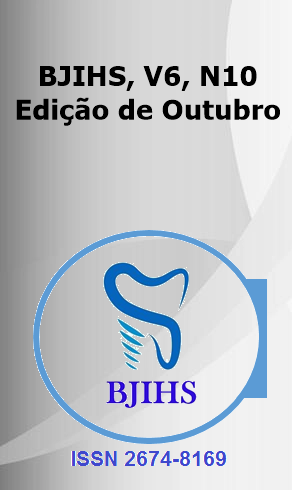Resumo
As restaurações cerâmicas são amplamente utilizadas na Odontologia. Estas restaurações costumam necessitar de ajustes intraorais com pontas diamantadas após serem cimentadas, resultando em um aumento da rugosidade superficial da cerâmica. Portanto, diversos métodos de acabamento e polimento têm sido empregados para reduzir este problema, uma vez que, superfícies rugosas aumentam a predisposição à retenção de biofilme e aderência microbiana. O objetivo deste estudo foi avaliar a adesão bacteriana em uma cerâmica reforçada por dissilicato de lítio submetida a diferentes protocolos de acabamento e polimento. Foram confeccionados 50 corpos de prova obtidos a partir de blocos cerâmicos pré-fabricados subdivididos em 5 grupos (n=10): G1 controle – somente glaze, G2 polidores American Burrs, G3 DHpro, G4 KG e G5 EVE. Somente o G1 não recebeu a sequência de ajustes clínicos com pontas diamantadas 4138 F e FF. Após, os corpos de prova foram contaminados com Streptococcus mutans, lavados com PBS (tampão fosfato salino) e submetidos a sonificação com posterior contagem de UFC/ml e realização de microscopia de varredura de varredura. O grupo controle, glaze, não diferiu estatisticamente dos grupos polidos com Dhpro, American Burrs e EVE, entretanto, diferiu estatisticamente do grupo polido com KG. Todos os grupos estudados formaram uma superfície capaz de permitir a adesão do Streptococcus mutans à cerâmica reforçada por dissilicato de lítio.
Referências
Mohammadibassair M, Rezvani MB, Golzari H, Salehi EM, Fahimi MA, Fard MJK. Effect of Two Polishing Systems on Surface Roughness, Topography, and Flexural Strength of a Monolithic Lithium Disilicate Ceramic. J Prosthodont 2017; 28(1): 1-9.
Aguiar EMG, Rodrigues RB, Lopes CCA, Silveira Júnior CD, Soares CJ, Novais VR. Diferentes sistemas cerâmicos na reabilitação oral: relato de caso clínico. Rev Odontol Bras Central, 2016; 25(72): 31-36.
Verde FAV, Pupo YM, Kose C, Gomes GM, Gomes JC. Previsibilidade com cerâmicas em dentes anteriores: IPS e.max Press e e.max Ceram. Rev. Dental Press Estét, 2011; 8(1): 76-88.
Andrade AO, Silva IVS, Vasconcelos MG, Vasconcelos RG, Cerâmicas odontológicas: classificação, propriedades e considerações clínicas. Rev Salusvita 2017; 36(4): 1129-1152.
Boaventura JMC, Nishida R, Elossais AA, Lima DM, Reis JMSN, Campos EA, Andrade MF. Effect finishing and polishing procedures on the surface roughness of IPS Empress 2 ceramic. Acta Odontol Scand 2013; 71(3-4): 438-443.
Vichi A, Fonzar RF, Goracci C, Carraba M, Ferrari M. Effect of Finishing and Polishing on Roughness and Gloss of Lithium Disilicate and Lithium Silicate Zirconia Reinforced Glass Ceramic for CAD/CAM Systems. Oper Dent 2018; 43(1): 90-100.
Kumchai H, Juntavee P, Sun AF, Nathanson D. Effect of Glazing on Flexural Strength of Full-Contour Zirconia. Int J Dent 2018; 2018:1-6.
Mores RT, Borba M, Corazza PH, Della Bona A, Benetti P. Influence of surface finishing on fracture load failure mode of glass ceramic crowns. JPD 2017; 118(4): 511-516.
Bini N, Vasconcellos FJ, Gouvea CVD, Carvalho W, Ferreira VF, Oliveira H. Rugosidade Superficial de uma Cerâmica Glazeada e Submetida a Diferentes Sistemas de Polimento. Pesquisa Brasileira em Odontopediatria e Clinica Integrada 2011; 11(4): 481-484.
Martins LM, Lorenzoni FC, Farias BC, Lopes LDS, Bonfante G, Rubo JH. Comportamento biomecânico das cerâmicas odontológicas: revisão. Cerâmica 2010; 56(338): 148-155.
Vieira AC, Oliveira MCS, Lima EMCX, Rambob I, Leite M. Evaluation of the Surface Roughness in Dental Ceramics Submitted to Different Finishing and Polishing Methods. J Indian Prosthodont Soc 2013; 13(3): 290–295.
Vasconcellos BT, Macedo MRP, Oda M, Gerone Netto N. Avaliação da rugosidade superficial de um material cerâmico sob diferentes tratamentos. Rev Inst Ciênc Saúde 2008; 26(1): 82-86.
Mota EG, Nunes LS, Fracasso LM, Burnett JR LH, Spohr AM. The effect of milling and post milling procedures on the surface roughness of CAD/CAM materials. J Esthet Restor Dent 2017; 29(6): 450-458.
Incesu E, Yanikoglu N. Evaluation of the effect of different polishing systems on the surface roughness of dental ceramics. J Prosthet Dent. 2020 Jul;124(1):100-109.
Kulvarangkun A, Panyayong W, Pumpaluk P. Experimental Study of Surface Roughness of Dental Ceramics After Polishing with Three Types of Polishing Systems. J Int Soc Prev Community Dent. 2022 Oct 31;12(5):540-546.
Olivieri KAN, Pelissari LP, Teixeira ML, Miranda ME. Avaliação da rugosidade superficial de duas cerâmicas odontológicas submetidas a diferentes tratamentospolidores. Rev Dental Press Estét 2013; 10(1): 96-107.
Aykent F, Yondem I, Ozyesil AG, Gunal SK, Avunduk MC, Ozkan S. Effect of different finishing techniques for restorative materials on surface roughness and bacterial adhesion. J Prosthet Dent. 2010 Apr;103(4):221-7.
Al-Marzok MI, Al-Azzawi HJ. The effect of the surface roughness of porcelain on the adhesion of oral Streptococcus mutans. J Contemp Dent Pract. 2009 Nov 1;10(6):E017-24.
Steiner R, Beier US, Heiss-Kisielewsky I, Engelmeier R, Dumfahrt H, Dhima M. Adjusting dental ceramics: An in vitro evaluation of the ability of various ceramic polishing kits to mimic glazed dental ceramic surface. J Prosthet Dent. 2015 Jun;113(6):616-22.
Kawai K, Urano M, Ebisu S. Effect of surface roughness of porcelain on adhesion of bacteria and their synthesizing glucans. J Prosthet Dent. 2000 Jun;83(6):664-7.
Dutra D, Pereira G, Kantorski KZ, Valandro LF, Zanatta FB. Does Finishing and Polishing of Restorative Materials Affect Bacterial Adhesion and Biofilm Formation? A Systematic Review. Oper Dent. 2018 Jan/Feb;43(1):E37-E52.
Haralur SB. Evaluation of efficiency of manual polishing over autoglazed and overglazed porcelain and its effect on plaque accumulation. J Adv Prosthodont. 2012 Nov;4(4):179-86. doi: 10.4047/jap.2012.4.4.179. Epub 2012 Nov 29.
Kurt M, Bankoğlu Güngör M, Karakoca Nemli S, Turhan Bal B. Effects of glazing methods on the optical and surface properties of silicate ceramics. J Prosthodont Res. 2020 Apr;64(2):202-209.
Shibasaki PAN, Cavalli V, Oliveira MC, Barbosa JP, Boriollo MFG, Martins LRM. Influence of Surface Treatment on the Physical Properties and Biofilm Formation of Zirconia- Reinforced Lithium Silicate Ceramics: In Vitro Trial. Int J Prosthodont. 2023 Sep 12;36(4):460-468.

Este trabalho está licenciado sob uma licença Creative Commons Attribution 4.0 International License.
Copyright (c) 2024 Jaqueline Schlindwein, Rafaela Piardi, Mariá Cortina Bellan, Marília Paulus, Juliane Pereira Butze, Daniel Galafassi
